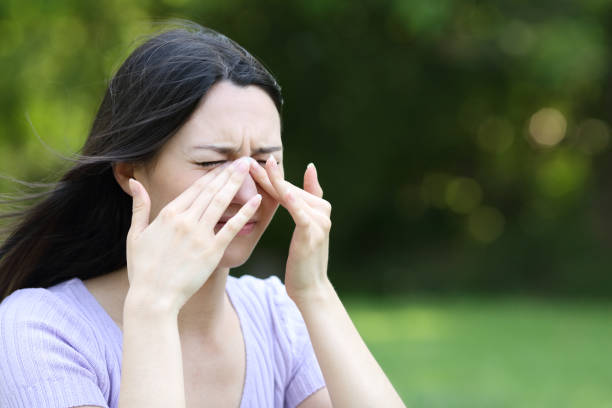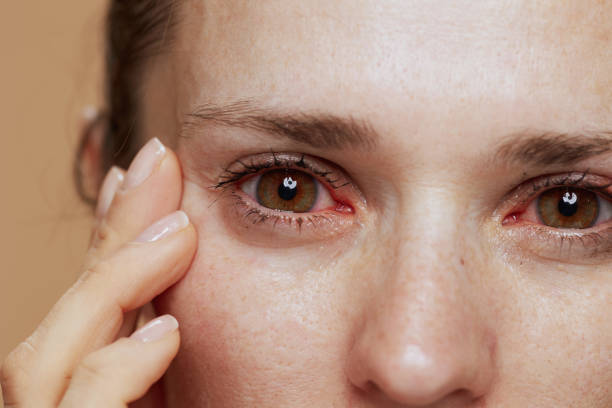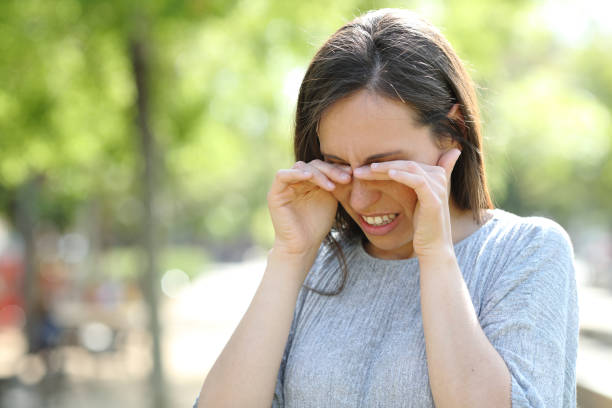What is Dry Eye Syndrome?
Dry Eye Syndrome (DES) is a widespread eye condition that happens when your eyes are unable to produce enough tears or when the tears evaporate too quickly. Tears are important for keeping your eyes moist, and without enough of them, your eyes can feel irritated, dry, and uncomfortable. In some cases, this lack of moisture can even cause damage to the surface of your eye. Although dry eyes are sometimes temporary, chronic Dry Eye Syndrome can significantly impact your daily activities and overall quality of life. It’s important to understand the common causes, symptoms, and available treatment options to manage and relieve the discomfort of dry eyes effectively.
Symptoms of Dry Eye Syndrome
Dry Eye Syndrome can vary in severity, from mild irritation to more intense discomfort. The symptoms you feel can differ depending on how severe the condition is. Some of the most common signs of dry eyes include:
- A stinging or burning sensation in the eyes
- A feeling of something being stuck in the eye (foreign body sensation)
- Redness or irritation in the eye area
- Watery eyes (which may seem surprising, but eyes may water to try and compensate for dryness)
- Blurred vision, especially after long periods of use
- Difficulty wearing contact lenses comfortably
- Eye fatigue or feeling tired in the eyes
If you find yourself experiencing these symptoms on a regular basis, it’s a good idea to consult an eye care professional for advice and treatment options.

Causes of Dry Eye Syndrome
Dry Eye Syndrome can be triggered by a variety of factors, which may occur alone or work together to worsen the condition. Understanding the underlying causes is key to managing and treating dry eyes. Some of the most common causes of Dry Eye Syndrome include:
1. Age
As we get older, our bodies naturally produce fewer tears, which makes dry eyes more common, especially after the age of 50. Hormonal changes, particularly in women going through menopause, can also play a significant role in reducing tear production. This decrease in tears can make the eyes feel drier and more uncomfortable.
2. Environmental Factors
Exposure to dry air, wind, smoke, and air conditioning can cause your eyes to lose moisture more quickly, making them feel dry and irritated. People who live in areas with high levels of pollution, dust, or strong winds may also be at a higher risk for developing dry eyes. These environmental factors can make it harder for your eyes to stay properly hydrated, leading to increased discomfort.
3. Medications
Certain medications, including antihistamines, antidepressants, and blood pressure medications, can reduce the amount of tears your eyes produce. This decrease in tear production can lead to dryness and discomfort in the eyes. If you are taking any of these medications and are experiencing dry eyes, it may be worth discussing with your healthcare provider to explore possible solutions or alternatives.
4. Health Conditions
Health conditions such as diabetes, rheumatoid arthritis, and thyroid disorders can increase the risk of developing Dry Eye Syndrome. These medical issues can affect how your body produces and maintains tears. In some cases, autoimmune diseases may directly impact the tear glands, reducing tear production and causing inflammation in the eyes. This combination can lead to ongoing dryness and discomfort if not properly managed.
5. Digital Eye Strain
Spending long periods of time looking at screens—like computers, tablets, or phones—can lead to a problem called digital eye strain. This condition can cause or make dry eyes worse. When you stare at a screen, you tend to blink less often, which means your eyes don’t get the moisture they need. This reduced blinking causes your tears to evaporate more quickly, leading to dryness, irritation, and discomfort.
6. Contact Lenses
Wearing contact lenses for long periods, especially if they don’t fit well, can lead to dryness and irritation in the eyes. Contact lenses can reduce the amount of oxygen reaching the eye’s surface and may absorb moisture, leaving your eyes feeling dry. If contacts are worn for too many hours without enough moisture, dry eye symptoms can become worse. Proper fit, good hygiene, and regular breaks can help reduce the risk of dryness caused by contact lens use.
Diagnosing Dry Eye Syndrome
If you’re noticing symptoms of dry eyes, it’s important to see an eye doctor for a proper diagnosis. An eye care professional can perform several simple tests to find out what’s causing your symptoms and how serious the condition is. These tests may include:
- Schirmer Test: A small paper strip is placed under your lower eyelid to measure how much tears your eyes produce.
- Tear Breakup Time: This test checks how quickly your tears evaporate after you blink, helping to see if your tears are staying on the eye long enough.
- Ocular Surface Staining: A special dye is gently applied to the eye’s surface to highlight any damage or dryness on the eye.
With the results from these tests, your doctor can understand the level of dryness and choose the best treatment plan to help relieve your symptoms and protect your eye health.

Treatment Options for Dry Eye Syndrome
The good news is that Dry Eye Syndrome is treatable. There are several options available, depending on the cause and severity of your symptoms. Below are some of the most common treatments:
1. Artificial Tears
The most common treatment for Dry Eye Syndrome is the use of artificial tears, which help lubricate the eyes and provide relief from discomfort. There are several different types of artificial tears, ranging from over-the-counter drops to prescription options for more severe cases.
2. Prescription Medications
If artificial tears are not sufficient, your doctor may recommend prescription medications to increase tear production or reduce inflammation. Some options include:
- Cyclosporine A (Restasis): This medication helps reduce inflammation in the eyes and promotes tear production.
- Lifitegrast (Xiidra): This medication works to reduce inflammation and improve tear production.
3. Punctal Plugs
For those with chronic dry eyes, punctal plugs may be used. These tiny devices are inserted into the tear ducts to block the drainage of tears, helping to keep your eyes moist for longer periods.
4. Warm Compresses and Eyelid Hygiene
Applying a warm compress to your eyes can help loosen blocked oil glands and improve tear production. Additionally, practicing proper eyelid hygiene by cleaning your eyelids with a gentle solution can help reduce inflammation and improve tear flow.
5. Lifestyle Changes
Making simple lifestyle changes can have a significant impact on managing dry eyes. Some of these changes include:
- Taking regular breaks when working on a computer or using digital devices (the 20-20-20 rule: every 20 minutes, look at something 20 feet away for 20 seconds).
- Using a humidifier to add moisture to the air, especially in dry environments.
- Wearing protective eyewear such as sunglasses to shield your eyes from wind and dust.
- Maintaining a healthy diet rich in omega-3 fatty acids, which have been shown to improve tear production.
6. Surgery
In rare cases where other treatments don’t work, surgical options may be considered. This can include procedures to block the tear ducts or improve the function of the tear-producing glands.
Prevention of Dry Eye Syndrome
While some causes of dry eyes—such as aging and certain medical conditions—can’t be avoided, there are still many ways you can help prevent the condition from getting worse:
- Take regular breaks from screens to rest your eyes and reduce strain.
- Use lubricating eye drops, especially if you’re in dry, windy, or air-conditioned spaces.
- Drink plenty of water throughout the day to keep your body and eyes well-hydrated.
- Include omega-3-rich foods in your diet, like fish, flaxseeds, and walnuts, to support tear production.
- Protect your eyes from harsh elements by wearing sunglasses or goggles when outdoors in windy, dusty, or smoky environments.
These simple steps can make a big difference in managing dry eye symptoms and protecting your eye health.

When to See an Eye Care Professional
If you’re dealing with ongoing discomfort or your dry eye symptoms are getting worse, it’s important to see an eye care professional as soon as possible. A specialist can find the root cause of your dry eyes and suggest the most effective treatment based on your unique needs. Getting help early can prevent the condition from becoming more serious. If left untreated, dry eyes can lead to complications like eye infections, damage to the cornea, or even long-term vision problems. Taking action now can help protect your eyes and improve your overall comfort.
Conclusion
Dry Eye Syndrome can be a frustrating and uncomfortable condition that affects your ability to enjoy everyday activities. It may cause irritation, blurred vision, or trouble wearing contact lenses, making daily tasks more difficult. The good news is that, with the right treatment and simple lifestyle changes, you can manage the symptoms and find relief.
If you’re dealing with dry eyes, don’t ignore the signs—schedule a visit with an eye care professional to discuss your symptoms and explore treatment options that fit your needs.
By following a personalized treatment plan and making small changes to your routine, you can protect your eyes, improve moisture levels, and reduce discomfort. Don’t wait—take charge of your eye health today and start feeling better!

